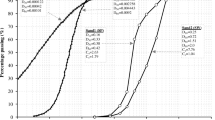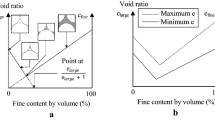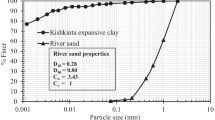Abstract
Compacted sand–expansive clay mixture with low hydraulic conductivity and appropriate shear strength is employed as liner systems for waste containment systems to prevent groundwater contamination by leachate from the waste. The aim of this study was to assess the shear strength behavior and swelling potentials of sand–attapulgite clay mixtures. The attapulgite clay used in this study was obtained from the eastern province of Saudi Arabia and was characterized as highly expansive. A detailed experimental program was devised to evaluate the effects of clay content (ranging between 0 and 60 %), initial molding conditions (optimum and wet-of-optimum), normal stress, and wetting conditions (as-compacted and inundated) on shear strength behavior. Also, the effects of clay content and initial molding conditions on the swelling potential of the mixture were evaluated. Test results revealed different trends for the shear stress–strain curves, signifying that different structural arrangements resulted from the use of different clay contents and molding conditions. Furthermore, test results identified an optimum clay content of 30 % which yielded the maximum shear strength; beyond this, a significant reduction in the shear strength of the sand–attapulgite clay mixture was observed. Finally, the shear strengths of sand–attapulgite clay mixtures were compared to those of sand–bentonite mixtures.

















Similar content being viewed by others
References
Abduljauwad SN (1994) Swelling behavior of calcareous clays from the Eastern Province of Saudi Arabia. Q J Eng Geol 27:333–351
Abduljauwad SN, Sulaimani GJ, Basunbal IA, Al-Buraim I (1998) Laboratory and field studies of response of structures to heave of expansive clay. Geotechnique 48(1):103–121
Abichou T, Benson CH, Edil TB (2002) Micro-structure and hydraulic conductivity of simulated sand–bentonite mixtures. Clay Clay Miner 50:537–545
Aiban SA (2006) Compressibility and swelling characteristics of Al-Khobar Palygorskite, eastern Saudi Arabia. Eng Geol 87:205–219
Al-Amoudi OSB, Abduljauwad SN (1995) Compressibility and collapse potential of an arid, saline sabkha soil. Eng Geol 39(3):185–202
Al-Shayea N (2001) The combined effect of clay and moisture content on the behavior of remolded unsaturated soils. Eng Geol 62:319–342
ASTM (1996) ASTM D4546: standard test methods for one dimensional swell or settlement potential of cohesive soils. Annual book of ASTM Standards, vol 04.09. ASTM, West Conshohocken
ASTM (1998a) ASTM D3080: standard test method for direct shear test of soils under consolidated drained conditions. Annual book of ASTM Standards, vol 04.09. ASTM, West Conshohocken
ASTM (1998b) ASTM D698: standard test methods for laboratory compaction characteristics of soil using standard effort (12 400 ft lbf/ft3 (600 kn m/m3). Annual book of ASTM Standards, vol 04.09. ASTM, West Conshohocken
Azam S (2003) Influence of mineralogy on swelling and consolidation of soils in eastern Saudi Arabia. Can Geotech J 40(5):964–975
Azam S (2006) Large-scale odometer for assessing swelling and consolidation behavior of Al-Qatif clay expansive soil. In: Al-Rawas AA (eds) Expansive soils: recent advances in characterization and treatment. Bull Eng Geol Env 66:85–99
Azam S, Abduljauwad SN, Al-Shayea NA, Al-Amoudi OSB (1998) Expansive characteristics of gypsiferous/anhydritic formations. Eng Geol 51:89–107
Bayoglu E (1995) Shear strength and compressibility behavior of sand–clay mixtures. M.S. thesis. Middle East Technical University, Ankara
Broderick G, Daniel DE (1990) Stabilizing compacted clay against chemical attack. J Geotech Eng-ASCE 116(10):1549–1567
Chalermyanont T, Arrykul S (2005) Compacted sand–bentonite mixtures for hydraulic containment liners. Songklanakarin J Sci Technol 27(2):313–323
Chen Y, Meehan CL (2011) Undrained strength characteristics of compacted bentonite–sand mixtures. In: Han J, Alzamora D (eds) Geo-Frontiers 2011-ASCE, Geotechnical Special Publications (GSP) 211. ASCE, Reston, pp 2699–2708
Day SR (1994) The compatibility of slurry cutoff wall materials with contaminated groundwater. In: Daniel DE, Trautwein SJ (eds) ASTM STP 1142: hydraulic conductivity and waste contaminant transport in soils. ASTM, West Conshohocken, pp 284–299
El-Naggar Z (1988) Foundation problems in sabkha deposits. Short course on foundation engineering for practicing engineers. CE Department, KFUPM, Dhahran, pp SD1–SD54
Georgianou V, Burland J, Hight D (1990) The undrained behavior of clayed sands in triaxial compression and extension. Geotechnique 41(3):383–393
Gipson AH Jr (1985) Permeability testing on clayey soil and silty sand–bentonite mixture using acid liquor. In: Johnson AI (eds) ASTM STP 874: hydraulic barriers in soil and rock. ASTM, West Conshohocken, pp 140–154
Gleason MH, Daniel DE, Eykhnlt GR (1997) Calcium and sodium bentonite for hydraulic containment applications. J Geotech Geoenviron 123(5):438–445
Gueddouda MK, Goual I, Lamara M, Aboubaker N (2008) Hydraulic conductivity and shear strength of compacted dune sand–bentonite mixtures. In: Proc Int Conf on Construction and Building Technology (ICCBT 2008), 16–20 June 2008, Kuala Lumpur, pp 139–150
Jafari MK, Shafiee A (2004) Mechanical behavior of compacted composite clays. Can Geotech J 41:1152–1167
Konyuhov AI, Maleki B (2006) The Persian Gulf Basin: geological history, sedimentary formations, and petroleum potential. Lithol Miner Resour 41(4):344–361
Kuerbis R, Negussey D, Vaid YP (1988) Effect of gradation and fine content on the undrained response of sand. Hydraulic fill structure. ASCE Geotechnical Special Publication 21. ASCE, New York, pp 330–345
Leelanitkul S (1989) Improving properties of active clay by sand admixtures. In: Kulhawy FH (ed) Foundation Engineering: Current Principles and Practices Conference, June 25–29, Evanston. ASCE, Reston, pp 381–391
Mitchell JK (1993) Fundamentals of soil behavior. Wiley, New York
Monkul MM, Ozden G (2005) Effect of intergranular void ratio on one-dimensional compression behavior. In: International Conference on Problematic Soils. International Society of Soil Mechanics and Geotechnical Engineering, Famagusta, pp 1203–1209
Novais-Ferreira H (1971) The clay content and the shear strength in sand–clay mixtures. In: Proc 5th African Reg Conf Soil Mech Found Eng, Luanda, Angola, Aug 1971, 1:3–9
Olmez MS (2008) Shear strength behavior of sand–clay mixtures. M.Sc. thesis, Middle East Technical University, Ankara
Pakbaz MS, Boroumanszadeh B (2007) Evaluation of factors affecting parameter m in drained shear strength of overconsolidated soils. Soil Sci 3:127–137
Pandian NS, Nagaraj TS, Raju P (1995) Permeability and compressibility behavior of bentonite–sand/soil mixes. Geotech Test J 18:86–93
Ryan CR (1987) Vertical barriers in soil for pollution containment. In: Woods RD (ed) Geotechnical Practice for Waste Disposal ‘87, ASCE Geotechnical Special Publication No. 13. ASCE, New York, pp 182–204
Shackelford CD (1994) Waste–soil interactions that alter hydraulic conductivity. In: Daniel DE, Trautwein SJ (eds) ASTM STP 1142: hydraulic conductivity and waste contaminant transport in soil. ASTM, West Conshohocken, pp 111–168
Slater DE (1983) Potential expansive soils in Arabian Peninsula. J Geotech Eng-ASCE 109:744–746
Thevanayagam S (1998) Effect of fines and confining stress on undrained shear strength of silty sands. J Geotech Geoenviron 124(6):479–491
Acknowledgments
This paper is a part of a research project supported through the NPST program by King Saud University, project no. 11-BUI-1901-02. The authors also thank the technicians and staff of Bugshan Research Chair in Expansive Soils for their help and support.
Author information
Authors and Affiliations
Corresponding author
Rights and permissions
About this article
Cite this article
Elkady, T.Y., Shaker, A.A. & Dhowain, A.W. Shear strengths and volume changes of sand–attapulgite clay mixtures. Bull Eng Geol Environ 74, 595–609 (2015). https://doi.org/10.1007/s10064-014-0653-1
Received:
Accepted:
Published:
Issue Date:
DOI: https://doi.org/10.1007/s10064-014-0653-1




